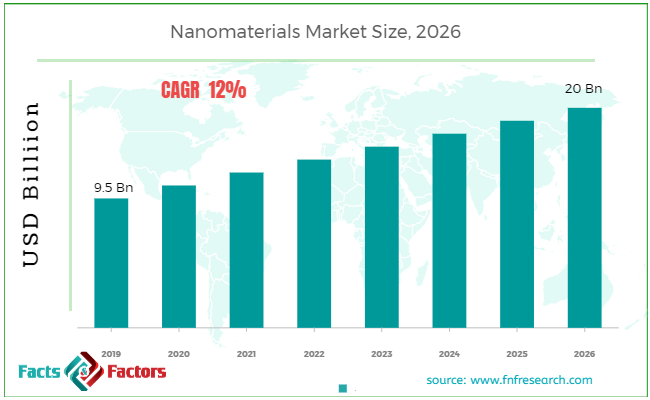 en
en  en
en  en
en  en
en 
[210+ Pages Report] According to the report published by Facts Factors, the global nanomaterials market size was worth around USD 9.5 billion in 2019 and is predicted to grow to around USD 20 billion by 2026 with a compound annual growth rate (CAGR) of roughly 12% between 2020 and 2026. The report analyzes the global nanomaterials market drivers, restraints/challenges, and the effect they have on the demands during the projection period. In addition, the report explores emerging opportunities in the nanomaterials market.

This specialized and expertise oriented industry research report scrutinizes the technical and commercial business outlook of the Nanomaterials industry. The report analyzes and declares the historical and current trends analysis of the Nanomaterials industry and subsequently recommends the projected trends anticipated to be observed in the Nanomaterials market during the upcoming years.
The nanomaterials market report analyzes and notifies the industry statistics at the global as well as regional and country levels in order to acquire a thorough perspective of the entire Nanomaterials market. The historical and past insights are provided for FY 2016 to FY 2019 whereas projected trends are delivered for FY 2020 to FY 2026. The quantitative and numerical data is represented in terms of both volume (Kilo Tons) and value (USD Million) from FY 2016 – 2026.
 Key Insights from Primary Research
Key Insights from Primary Research Key Recommendations from Analysts
Key Recommendations from AnalystsThe quantitative data is further underlined and reinforced by comprehensive qualitative data which comprises various across-the-board market dynamics. The rationales which directly or indirectly impact the Nanomaterials industry are exemplified through parameters such as growth drivers, restraints, challenges, and opportunities among other impacting factors.
Throughout our research report, we have encompassed all the proven models and tools of industry analysis and extensively illustrated all the key business strategies and business models adopted in the Nanomaterials industry. The report provides an all-inclusive and detailed competitive landscape prevalent in the Nanomaterials market.
The report utilizes established industry analysis tools and models such as Porter’s Five Forces framework to analyze and recognize critical business strategies adopted by various stakeholders involved in the entire value chain of the Nanomaterials industry. The Nanomaterials market report additionally employs SWOT analysis and PESTLE analysis models for further in-depth analysis.
The report study further includes an in-depth analysis of industry players' market shares and provides an overview of leading players' market position in the Nanomaterials sector. Key strategic developments in the Nanomaterials market competitive landscape such as acquisitions & mergers, inaugurations of different products and services, partnerships & joint ventures, MoU agreements, VC & funding activities, R&D activities, and geographic expansion among other noteworthy activities by key players of the Nanomaterials market are appropriately highlighted in the report.
The growth of electronics and solar energy is estimated to generate significant demand for nanomaterials. The rise in the electronics manufacturing units in the Asia Pacific market is expected to create a lucrative demand for nanomaterials. The global shift to clean solar energy is one of the driving factors of the market. However, an increase in the cost of specialized nanomaterials may shift the end-user industry to the low-cost substitutes.
The Nanomaterials market research report delivers an acute valuation and taxonomy of the Nanomaterials industry by practically splitting the market on the basis of different types, applications, and regions. Through the analysis of the historical and projected trends, all the segments and sub-segments were evaluated through the bottom-up approach, and different market sizes have been projected for FY 2020 to FY 2026.
 Report Scope
Report ScopeReport Attribute |
Details |
Market Size in 2019 |
USD 9.5 Billion |
Projected Market Size in 2026 |
USD 20 Billion |
CAGR Growth Rate |
12% CAGR |
Base Year |
2019 |
Forecast Years |
2020-2026 |
Key Market Players |
Strem Chemicals, Inc., Nanophase Technologies Corporation, American Elements, Nanostructured & Amorphous Materials, Inc., US Research Nanomaterials, Inc., Hyperion Catalysis International Inc., Nanocomposix, Inc., Quantum Materials Corp., Reade International Corporation, SkySpring Nanomaterials, Inc., Cytodiagnostics, Inc., NanoMaterials Technology Pte Ltd., Nanografi Nano Technology, Nanoshel, and Frontier Carbon Corporation., and Others |
Key Segment |
By Type, End-Use, and Region |
Major Regions Covered |
North America, Europe, Asia Pacific, Latin America, and the Middle East & Africa |
Purchase Options |
Request customized purchase options to meet your research needs. Explore purchase options |
The regional segmentation of the Nanomaterials industry includes the complete classification of all the major continents including North America, Latin America, Europe, Asia Pacific, and the Middle East & Africa. Further, country-wise data for the Nanomaterials industry is provided for the leading economies of the world.
The Nanomaterials market is segmented based on type and application. On the basis of type segmentation, the market is split into aluminum oxide nanoparticles, silicon dioxide, antimony tin oxide nanoparticles, titanium dioxide nanoparticles, bismuth oxide nanoparticles, graphene, copper oxide nanoparticles, carbon nanotubes, fullerene, and cerium oxide nanoparticles. In terms of application segmentation, the market is divided into aerospace, paints & coatings, automotive, electronics, energy & power, medical, and others.
 Some of the leading players in the global market include
Some of the leading players in the global market includeThe taxonomy of the Nanomaterials industry by its scope and segmentation is as follows:
 By Type Segmentation Analysis (Customizable)
By Type Segmentation Analysis (Customizable) By Application Segmentation Analysis (Customizable)
By Application Segmentation Analysis (Customizable) Regional Segmentation Analysis (Customizable)
Regional Segmentation Analysis (Customizable)

Copyright © 2024 - 2025, All Rights Reserved, Facts and Factors
 en
en  en
en